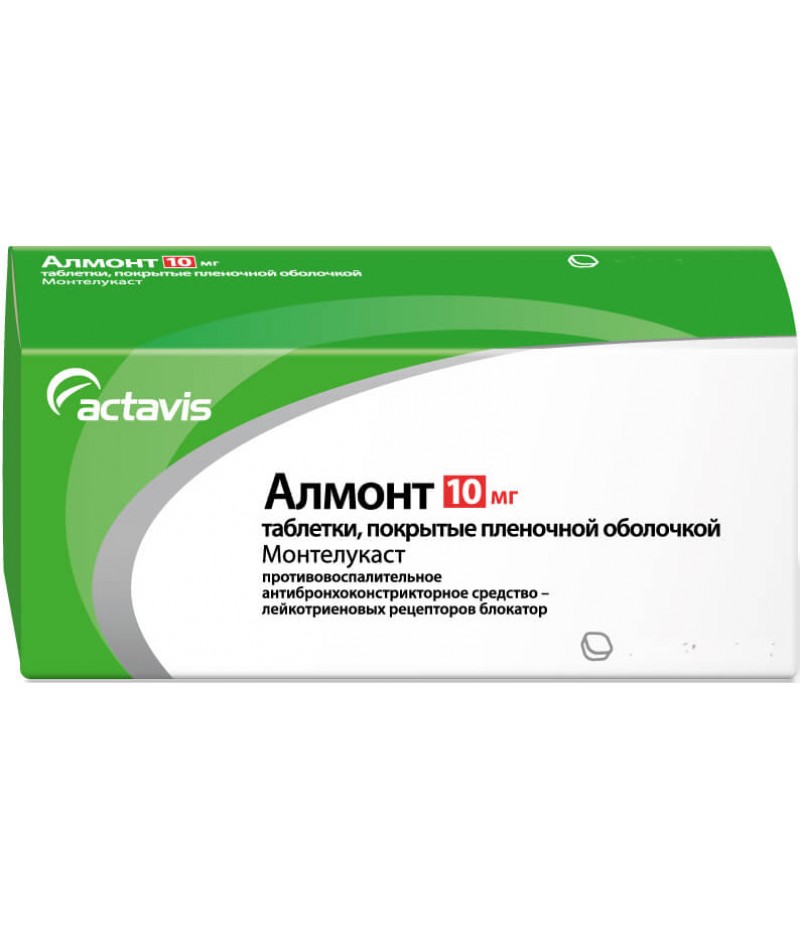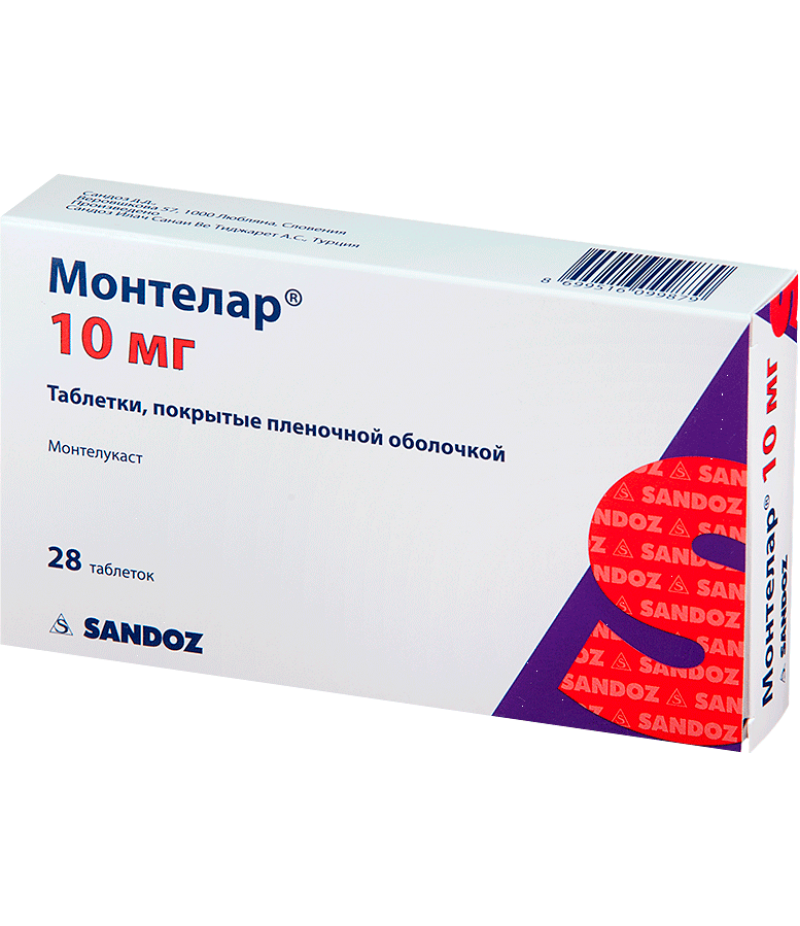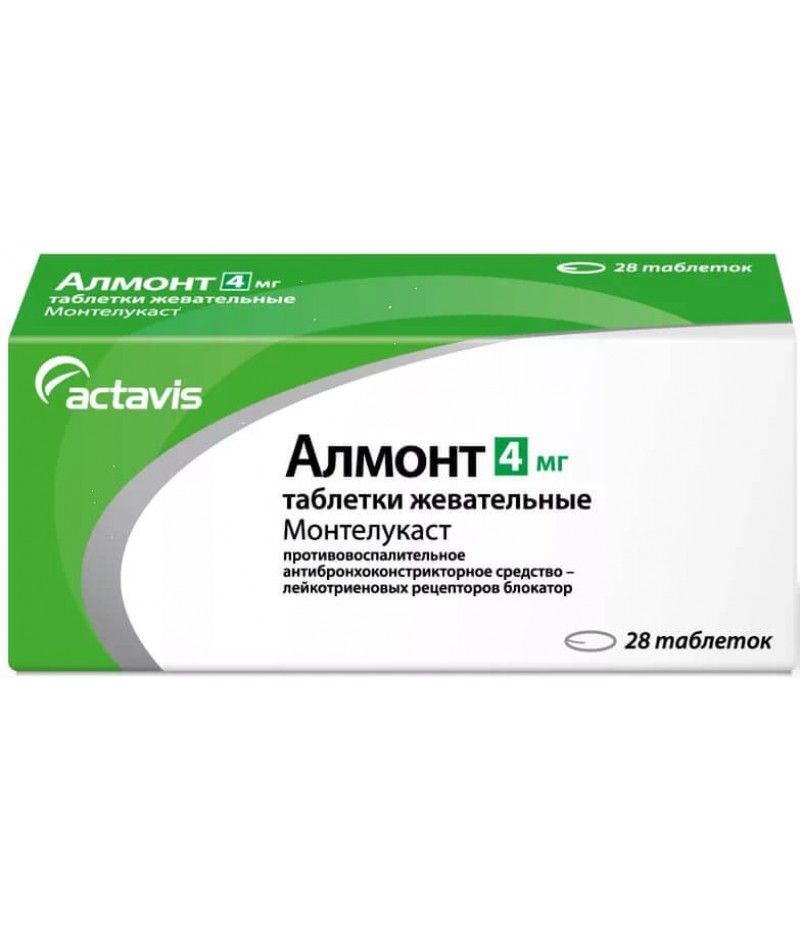Almont tablets 10mg #28
- $43.50$49.99
- Availability:In Stock
Almont tablets instructionReed more and buy Almont tablets herepharmachologic effectCysteinyl leukotrienes (LTC4, LTD4, LTE4) are strong pro-inflammatory eicosanoids that are released from various cells, including mast cells and e..
Tags: tabs
Almont tablets instruction
Reed more and buy Almont tablets here
pharmachologic effect
Cysteinyl leukotrienes (LTC4, LTD4, LTE4) are strong pro-inflammatory eicosanoids that are released from various cells, including mast cells and eosinophils. These important proastmatic mediators are associated with cysteinyl-leukotriene receptors (CysLT) present in the human respiratory tract and are responsible for the bronchospasm reaction, sputum production, vascular permeability and increased eosinophil count.
Almont is an orally active compound that has a high affinity and selectivity for CysLT 1 receptors. Montelukast in a dose of less than 5 mg couples bronchospasm induced by inhalation LTD4. Bronchodilator effect is observed within 2 hours after oral administration. The bronchodilating effect of betag-adrenomimetics is enhanced when taking montelukast. Almont suppresses both early and late stages of bronchospasm caused by the action of antigens. Almont reduces the number of eosinophils in peripheral blood in adults and children, and also significantly reduces the number of eosinophils in the respiratory tract. In patients with hypersensitivity to acetylsalicylic acid receiving inhaled and / or oral glucocorticosteroids (GCS), the addition to therapy of montelukast provides better control of the disease.
Pharmacokinetics
Suction
After oral administration, Montelukast is rapidly and almost completely absorbed. In adult patients, after taking chewable tablets at a dose of 5 mg on an empty stomach, the maximum concentration in the blood plasma (Stach) is reached after 2 hours. The average bioavailability is 73%, this value is reduced to 63% when taking Montelukast with food. After taking chewable tablets at a dose of 4 mg on an empty stomach in patients aged 2 to 5 years, the stach is reached after 2 hours. The mean Sta in this group of patients is 66% higher, and the mean Cmin is lower than that of adults when taking film-coated tablets at a dose of 10 mg.
Distribution
The binding of montelukast to plasma proteins is more than 99%. The volume of distribution in the equilibrium state averages 8-11 liters. Preclinical studies revealed minimal Montelukast penetration through
blood-brain barrier. After 24 hours after administration, the concentration of montelukast is also minimal in other tissues.
Metabolism
Almont is actively metabolized in the liver. When used in therapeutic doses, the concentration of metabolites of Montelukast in blood plasma in an equilibrium state in adults and children is not determined.
In vitro studies have shown that cytochrome P450 isoenzymes (ZA4, 2A6 and 2C9) are involved in the metabolism of montelukast, while at therapeutic concentrations, montelukast does not inhibit cytochrome P450 isoenzymes: ZA4, 2C9, 1A2, 2A6, 2C19 and 2D6. Metabolites have a slight therapeutic effect of Montelukast.
Excretion
The half-life of montelukast in young healthy adult volunteers ranges from 2.7 to 5.5 hours. The plasma clearance of montelukast in healthy adult volunteers averages 45 ml / min. After oral administration of montelukast, 86% of the total amount is excreted through the intestine for 5 days and less than 0.2% through the kidneys, which, along with data on its bioavailability, confirms the excretion of montelukast and its metabolites mainly with bile.
Pharmacokinetics in special cases
The pharmacokinetics of montelukast in women and men is the same.
In elderly patients or patients with mild to moderate hepatic insufficiency, correction of the dosage regimen of Montelukast is not required. The pharmacokinetics of montelukast in patients with renal insufficiency was not evaluated. Since montelukast and its metabolites are not excreted by the kidneys, dose adjustment in this category of patients is not required. Data on the character of the pharmacokinetics of montelukast in patients with severe impairment of liver function (more than 9 on the Child-Pugh scale) are not available.
When receiving high doses of montelukast (20 and 60 times higher than recommended doses for adults), a decrease in the concentration of theophylline in the blood plasma is observed. When taking montelukast in the recommended doses of 10 mg 1 time per day, this effect is not observed.
Almont, indications for use
Prophylaxis and long-term treatment of bronchial asthma in children, including:
\ 0009 warning of day and night symptoms of the disease (for children from 2 years and older);
Treatment of bronchial asthma in patients with hypersensitivity to acetylsalicylic acid (for children 6 years and older);
\ 0009 Prevention of bronchospasm caused by physical exertion (for children from 2 years and older).
Relief of seasonal and allergic rhinitis symptoms in children from 2 years.
Contraindications for Almont tablets
Hypersensitivity to the active or any auxiliary substance of Almont tablets;
The child's age is up to 2 years (for a dosage of 4 mg) and up to 6 years (for a dosage of 5 mg);
Patients with rare hereditary diseases: galactose intolerance, lactase deficiency or glucose-galactose malabsorption;
Phenylketonuria (contains aspartame).
Mode of application
Inside, the tablet should be chewed. Admission of the drug by children is carried out under the supervision of adults. Almont tablets should be taken 1 hour before or 2 hours after meals. With bronchial asthma or bronchial asthma and allergic rhinitis: For children aged 2 to 6 years - 1 chewable tablet at a dose of 4 mg once a day in the evening. For children aged 6 to 14 years - 1 chewing tablet at a dose of 5 mg once a day in the evening. For allergic rhinitis: For children aged 2 to 6 years - 1 chewable tablet at a dose of 4 mg once a day and for children aged 6 to 14 years - 1 chewable tablet at a dose of 5 mg once a day in individual mode depending on the time of the greatest exacerbation of symptoms. There is no need for dose adjustment within these age groups. General recommendations The therapeutic effect of the drug, allowing to control the symptoms of asthma, is achieved within a day after taking. The patient is recommended to continue taking Almont tablets, both during periods of controlled course of bronchial asthma, and during the exacerbation of bronchial asthma. Patients with renal insufficiency and patients with hepatic insufficiency of mild and moderate severity are not required to select a special dose. No dosage adjustment is required depending on the patient's sex. There is no data on the use of montelukast in patients with severe impairment of liver function.
Application in pregnancy and lactation
The use of the drug Almont in pregnancy is possible if the intended use for the mother exceeds the potential risk to the fetus.
The decision on the abolition of breastfeeding for the period of application of the drug Almont is made on the basis of an assessment of the prospective benefit to the mother and the potential risk to the child.
Side effects of Almont tablets
Infectious and parasitic diseases: upper respiratory tract infections. Disorders from the blood and lymphatic system: increased tendency to bleeding, thrombocytopenia.
Immune system disorders: hypersensitivity reactions, including anaphylaxis, eosinophilic liver infiltration.
Disorders of the psyche: pathological dreams, including nightmares;
hallucinations, insomnia, somnambulism, irritability, anxiety, anxiety; agitation, including aggressive behavior or hostility; tremor, depression, disorientation, suicidal thoughts and behavior (suicidal).
Disturbances from the nervous system: headache, dizziness, drowsiness, paresthesia / hypoesthesia, convulsions.
Impaired heart: a feeling of palpitations.
Disturbances from the respiratory system, chest and mediastinum: nasal bleeding.
Disorders from the gastrointestinal tract: diarrhea, dry mouth, dyspepsia, nausea, vomiting, abdominal pain, pancreatitis.
Disorders from the liver and bile ducts: increased activity of alanine aminotransferase and aspartate aminotransferase, hepatitis (including cholestatic, hepatocellular and mixed liver damage).
Violations of coeyuya and subcutaneous tissues: angioedema, a tendency to the appearance of bruising, urticaria, skin itching, rash, erythema nodosum, erythema multiforme.
Disturbances from the musculoskeletal and connective tissues: arthralgia, myalgia, including muscle cramps.
General disorders and disorders at the site of administration: asthenia / fatigue, malaise, edema, pyrexia, thirst.
In very rare cases, during the treatment with montelukast, the development of the Chard-Strauss syndrome was reported (see section Special instructions).
special instructions for Almont tablets
The drug Almont is not recommended for the treatment of acute attacks of bronchial asthma. Patients with bronchial asthma should always have emergency medications. When the onset of an acute attack should be used inhaled beta-adrenomimetics short-acting. Patients should consult their doctor as soon as possible if they need more inhalation of short-acting beta-adrenomimetics than usual.
Do not dramatically replace the drug Almont therapy with inhaled or oral GCS. There are no data proving the possibility of reducing the dose of oral GCS against the background of simultaneous administration of montelukast.
In rare cases, patients who receive anti-asthmatic drugs, including montelukast, may develop systemic eosinophilia, which is sometimes accompanied by clinical signs of vasculitis, the so-called Chard-Strauss syndrome, a condition that is eliminated by the use of systemic SCS. These cases, as a rule, are associated with a decrease in dose or cancellation of oral corticosteroids. It is impossible to exclude or establish the possibility that leukotriene receptor antagonists may be associated with the development of the Chard-Strauss syndrome. Therefore, doctors should be warned about the possibility of eosinophilia, vascular rash, increased pulmonary symptoms, heart complications and / or neuropathy in patients. Patients who developed the above symptoms, it is necessary to undergo a second examination, and the scheme of their treatment should be reviewed. Treatment with Almont does not lead to the prevention of bronchospasm in patients with increased sensitivity to acetylsalicylic acid, with the use of acetylsalicylic acid and other non-steroidal anti-inflammatory drugs.
The drug Almont contains aspartame, a source of phenylalanine. This drug may cause harm to patients with phenylketonuria.
The drug contains lactose monohydrate and should not be taken to patients with rare hereditary abortions: galactose intolerance, lactase insufficiency or glucose-galactose malabsorption.
Impact on the ability to drive vehicles and mechanisms
Typically, montelukast does not affect the ability to drive vehicles or work with other mechanisms, but very rarely some patients have experienced drowsiness and dizziness, when these symptoms appear, patients are not advised to drive vehicles and engage in other activities requiring concentration and speed psychomotor reactions.
Drug Interactions
In patients who simultaneously received phenobarbital, the area under the pharmacokinetic concentration-time curve of montelukast decreased by about 40%, however, no correction of the dosing regimen in such patients is required. Since montelukast is metabolized by the CYP3A4 isoenzyme, caution should be used, especially in children, if montelukast is simultaneously used with inducers of the CYP3A4 isoenzyme, such as phenytoin, phenobarbital and rifampicin. Montelukast can be prescribed together with other drugs traditionally used for the prevention and long-term treatment of bronchial asthma and / or allergic rhinitis. Montelukast at the recommended therapeutic dose did not have a clinically significant effect on the pharmacokinetics of the following drugs: theophylline, prednisone, prednisolone, oral contraceptives (ethinylestradiol / norethynodrel 35/1), terfenadine, digoxin and warfarin.
In vitro studies found that montelukast is a strong inhibitor of the isoenzyme CYP2C8. However, in studies of Almont tabletsg interaction in vivo of montelukast and rosiglitazone (a marker substrate, a representative of drugs primarily metabolized by the CYP2C8 isoenzyme), no confirmation of the inhibition of the isoenzyme CYP2C8 by montelukast has been obtained. Thus, in clinical practice, the effect of montelukast on CUR2C8-mediated metabolism of a number of drugs is not expected, including. paclitaxel, rosiglitazone, repaglinide.
In vitro studies have shown that montelukast is a substrate of the isoenzyme CYP2C8, and to a lesser extent isoenzymes CYP2C9 and CA4. Data from the clinical trial of drug interaction for montelukast and gemfibrozil (an inhibitor of both CYP2C8 and 2C9) demonstrate that gemfibrozil increases the effect of systemic exposure to montelukast 4.4-fold. The simultaneous administration of itraconazole, a strong inhibitor of the isoenzyme CYP3A4, together with gemfibrozil and montelukast did not lead to an additional increase in the effect of systemic exposure to montelukast. The effect of gemfibrozil on the systemic effect of montelukast can not be considered clinically significant on the basis of safety data when administered at doses exceeding the approved dose of 10 mg for adult patients (eg 200 mg / day for adult patients for 22 weeks and up to 900 mg / day for patients,
taking a drug for about one week, there were no clinically significant negative effects). Thus, when combined with gemfibrozilom dose adjustment montelukast is not required. According to the results of in vitro studies, clinically significant drug interactions with other known inhibitors of the CYP2C8 isoenzyme (for example, with trimethoprim) are not expected. In addition, the joint administration of montelukast with itraconazole alone did not result in a significant increase in the effect of systemic exposure to montelukast. Combined treatment with bronchodilators
The drug is a justified addition to monotherapy with bronchodilators if the latter do not provide adequate control of bronchial asthma. After the therapeutic effect is achieved, a gradual reduction in the dose of bronchodilators can be started. Combined treatment with inhaled glucocorticosteroids
Treatment with the drug Montelast provides an additional therapeutic effect to patients who use inhaled GCS. Once the stabilization of the condition is achieved, it is possible to begin a gradual reduction in the dose of GCS under the supervision of a physician. In some cases, complete cancellation of inhaled glucocorticosteroids is permissible, however, a sharp substitution of inhaled glucocorticosteroids for the preparation of Montelast is not recommended.
Overdose
Symptoms of drug overdose in patients with chronic bronchial asthma when administered at a dose exceeding 200 mg per day for 22 weeks and at a dose of 900 mg per day for 1 week are not revealed. There are reports of acute overdose of montelukast (when taking at least 1 g per day) in the postmarketing period and in clinical studies in adults and children. Clinical and laboratory data indicate that the safety profile of the drug is consistent in children, adults and elderly patients. The most common symptoms were thirst, drowsiness, vomiting, psychomotor agitation, headache and abdominal pain. Treatment: symptomatic therapy.
Storage conditions
Almont tablets should be stored out of reach of children, dry, protected from light at a temperature of no higher than 30 ° C.
Shelf life - 3 years.
Terms of sell
To buy Almont tablets the prescription is not required.




